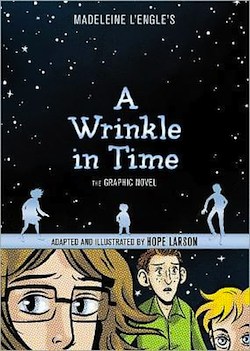I’ve always enjoyed seeing my favorite novels (or even pieces of them) portrayed in a visual medium. Normally that would be in movies or on television, but cover art, fan art, and other portrayals are also great for experiencing other people’s conception of the characters and places in the stories you love. I find it interesting to see how other people imagine things differently than I do, especially on the occasions when I am surprised by something that I actually like better than the way I imagined it. And while I knew I would probably not adopt Hope Larson’s depictions of Charles Wallace, Calvin, and Meg as my own, I couldn’t wait to see what she had done with one of my favorite books from childhood in A Wrinkle in Time: The Graphic Novel.
Of course, Hope Larson’s artistic style is already well-known and highly praised. I myself wasn’t familiar with her work before now, but after reading A Wrinkle in Time: The Graphic Novel, I can see what all the fuss is about. Not only is Larson’s style intricate and fun to look at, it’s clever. The panels are beautifully arranged and full of visual jokes, many of which actually made me chuckle out loud. Her representations of some of the more abstract concepts of the story—such as the walls and column of light imprisoning Mr. Murray, and the depictions of the characters mid-tesser—were artfully done. Of course, there were a few depictions that I didn’t like, simply because they didn’t mesh with what I pictured (especially Calvin) but others were strikingly similar to my own mental image (Meg), or were different but equally good. Her Aunt Beast may have been my favorite thing in the whole book.
The illustrations are done in black and white and a pale blue-grey. I did feel that the impact of seeing the world of A Wrinkle in Time was lost a little in the fact that there weren’t more hues involved. Seeing the Black Thing was much less dramatic when there was no colored world to contrast it to, and having a larger range of colors to work with would also have allowed Larson to differentiate more between the familiarity of Earth, the beauty of Uriel, the bleakness of Camazotz, and the colorlessness of Aunt Beast’s world. Of course, we don’t know if the coloring choices were the artist’s or the publisher’s, but at the point at which, in a visual story, we have to be told that a man’s eyes are red, the reader is left feeling a little let down. Full color is not necessarily needed, but at the very least, those red eyes should have been included—they really are needed for the impact of that moment to be felt. The black and white was very effective in certain areas, however, such as in the mass of identically dressed workers on Camazotz, amidst which the children looked delicate and lost in their whites and blues.
Larson did a good job choosing which parts of the narration to work back into the graphic novel, either by giving it to Meg as a thought or, occasionally, by including a few words right into the drawing itself, such as labeling the “creaking seventh step” or the skipping and bouncing of the too-rhythmic children of Camazotz. The places where she chose to make reference to the exact text of L’Engle’s novel, and the places where she didn’t, helped Larson put more of her own stamp on the story and the way in which we read it.
I really enjoyed A Wrinkle in Time: The Graphic Novel. It reminded me of so many of the things I loved about the story and even brought my attention to a few things I’d never noticed or paid attention to before. Seeing the layout of Meg’s attic bedroom, the storm, and the cat curled up on her bed reminded me of how much I identified with the scary oldest-child privilege of having the big bedroom all to yourself. (Where I first read A Wrinkle in Time.) And I adored how Larson drew Meg and her mother with similar features, reinforcing a suggestion from the novel that I never really caught on to as a teenage reader – that Meg is going to grow up to look a lot like her beauty of a mother. When Calvin sees Meg with her glasses off, and tells her that she has dreamboat eyes, Larson’s drawings really bring that home for us, and when Calvin’s baby blues disappear into the pupil-less IT state, we miss them just as much as Meg does.
I’d recommend the graphic novel to anyone who was a fan of the book, as a celebration and a rediscovery of a book they loved, but I would also recommend it to people who have never discovered the story before – I’d be very interested to know what a new reader thought of it.
You can read an excerpt from A Wrinkle in Time: The Graphic Novel here.
Kelsey Jefferson Barrett is a writer and a reader and a lover of fantastic horror. They live in Brooklyn and studies at Drew University; you can follow them on Twitter and read their short story “My Teacher, My Enemy” at Lightspeed Magazine.










